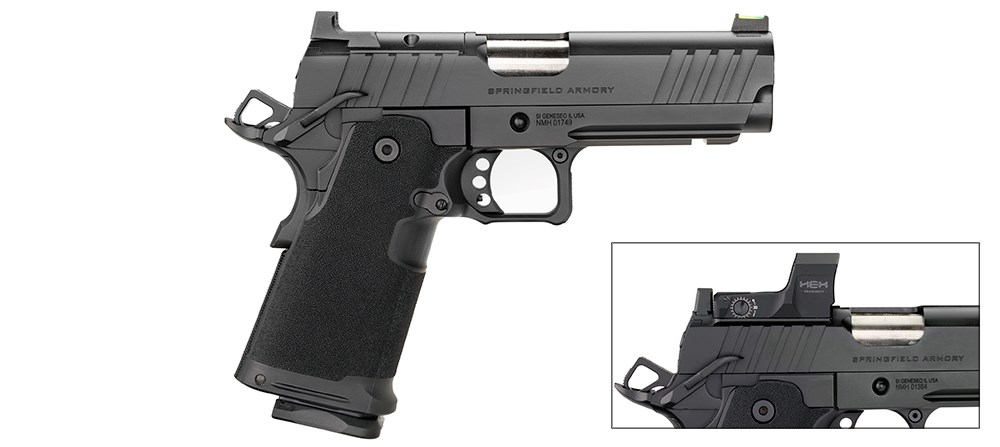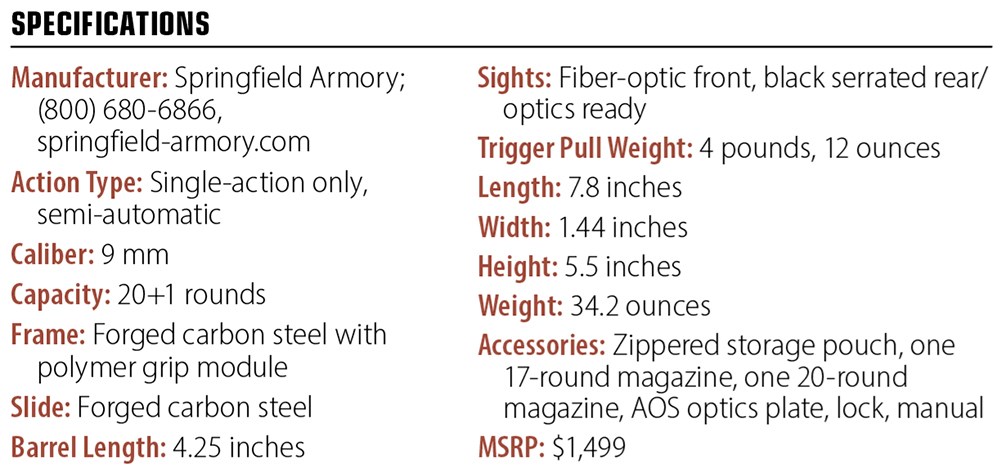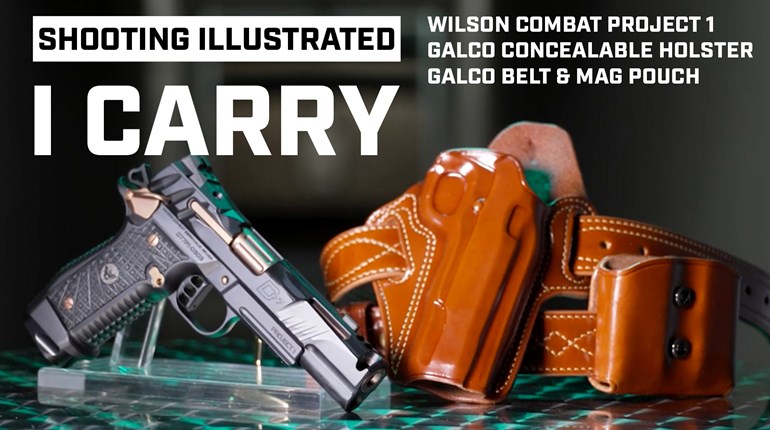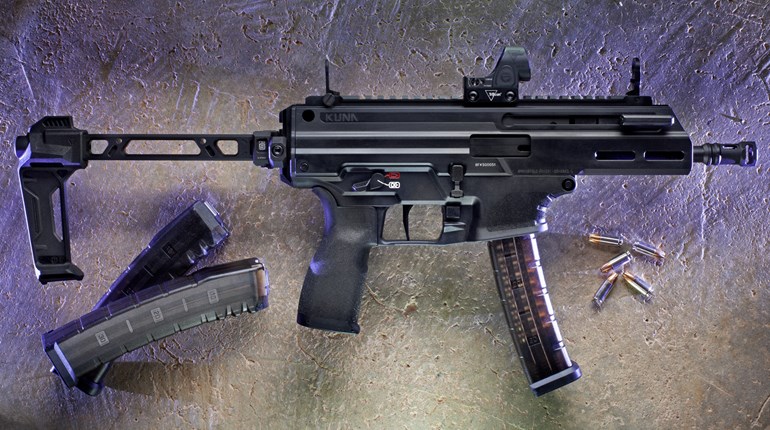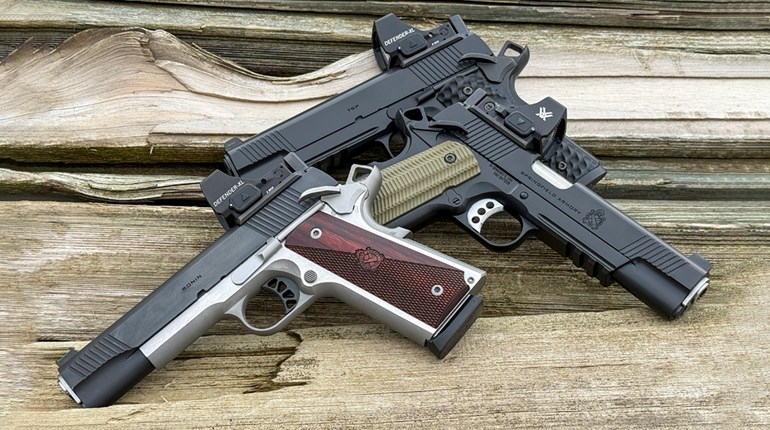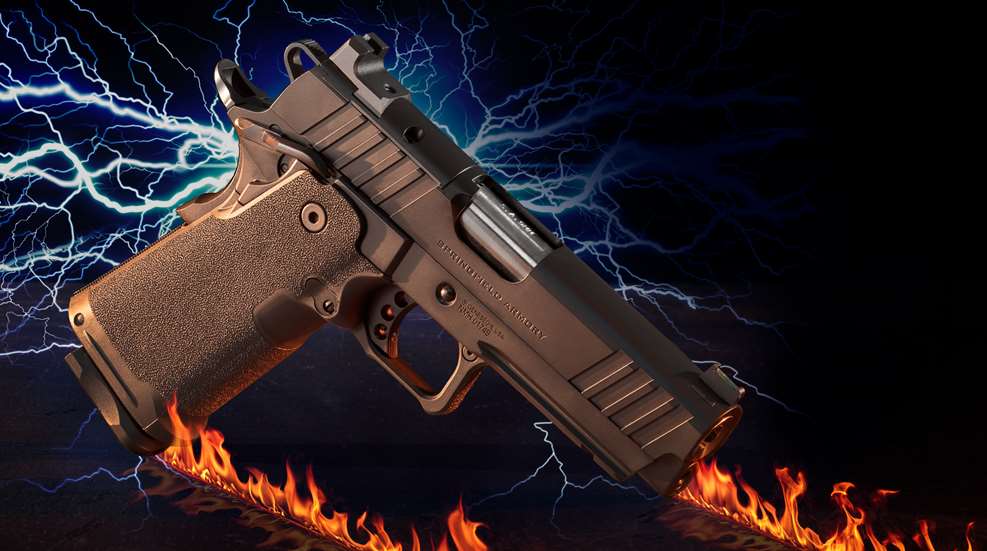
The last part of the 20th century was the age of the high-end 1911. But, with the new century we entered the era of the ever-shrinking 9 mm pistol. Springfield Armory capably filled that demand with its 18-ounce Hellcat. Last year the company introduced an excellent rendition of the Browning Hi Power—the SA-35—and it sold like face masks at a COVID convention. Springfield Armory has now made another bold, retro-like move. Again, bucking the little-pistol trend, it has introduced a double-stack, increased-capacity, 9 mm 1911 the manufacturer is calling the Prodigy.
The Prodigy takes me back to when I lusted for a Para-Ordnance 1911, and the comparison cannot be ignored. Though now defunct and lost within the integration and bankruptcy of Remington, Para-Ordnance was the king of the large-capacity 1911. Ironically, the company was founded in 1985 at the same time a very popular science fiction movie starring Michael J. Fox was released. This leaves me wondering if Springfield Armory is trying to take us “Back to the Future.” After several weeks of shooting two Prodigy pistols, I might be ready to go.
Simply put, the Prodigy is an increased-capacity, steel-frame 1911 compatible with modern aiming solutions, and is also equipped with a polymer grip module. Finding a place to start a more detailed description is difficult because with the Prodigy, Springfield Armory enhanced every major component of the 1911. Less elegantly, you might say the Prodigy is the result of a long courtship between a 1911 race gun and a 1911 carry gun.
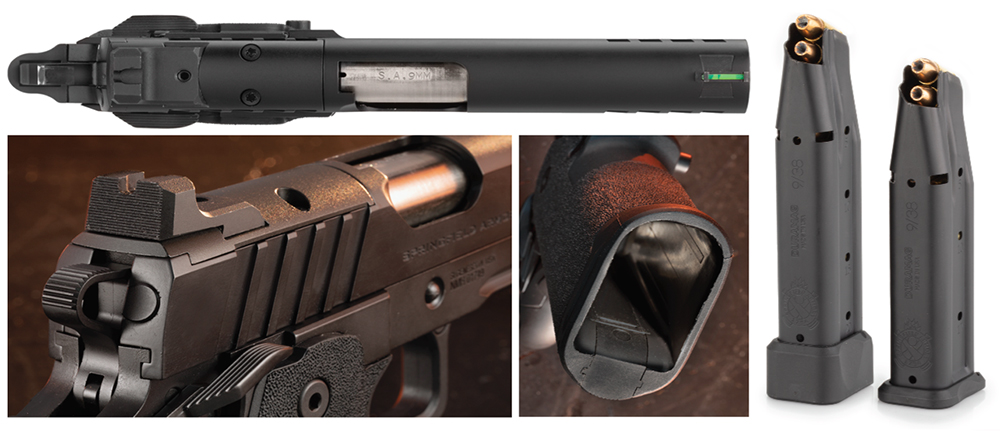
At the heart of the pistol is a forged, carbon-steel slide and frame. Unlike most every other factory 1911 on the market, the Prodigy does not have a barrel bushing; it’s fitted with a 4.25-inch, forged, stainless steel, match-grade, bushingless bull barrel, and a full-length guide rod. The guide rod does complicate full disassembly—you’ll need to use the supplied hex wrench—but barrel lockup at both ends is rock solid, and the slide cycles butter-smooth. Also, because of the guide rod, the recoil spring is contained when the slide is removed. This makes a quick wipe down and lube job easy.
The slide features cocking serrations front and rear and comes with a high-profile, fiber-optic front sight. The AOS acronym in the pistol’s name references the Agency Optics System reflex-sight compatibility. The slide has a cutout running from behind the ejection port to the end of the slide. A cover plate dovetailed for a high-profile rear sight that has a serrated and dot-less face fills this cutout. The Prodigy also comes with a mounting plate compatible with the Hex Dragonfly footprint. The optics plate is also dovetailed and features a high-profile rear sight similar to the one on the cover plate. But, because the AOS plate and rear sight are integral, and because the rear sight is matched to the reflex sight the plate is designed for, your open sights will perfectly co-witness with the reflex sight.
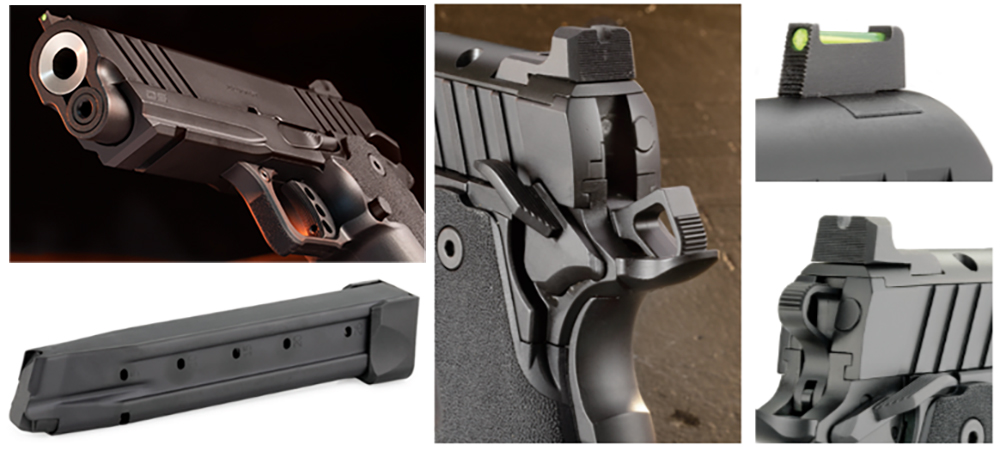
The other acronym in the Prodigy name is DS. This refers to the pistol’s double-stack magazine compatibility. Each Prodigy is shipped with a flush-fitting 17-round and an extended 20-round magazine. A 26-round extended magazine is also available, and all the magazines will retail for about $60. To make the Prodigy work with these wide-body mags, a uniquely engineered wide-body, polymer-grip module is solidly attached to the forged-steel frame. This grip module includes the squared trigger guard, and it has a very comfortable and not overly aggressive stippling treatment in all the right places.
The frame is fitted with an ambidextrous thumb safety and an extended grip safety with a memory pad bump to help with safety deactivation. The takedown lever is recessed into the frame on the left side, and the takedown pin is tastefully recessed on the right side. The dustcover section of the frame forward of the trigger guard is railed, with a single slot that allows for accessory attachment. Because of the shape of the frame, the Prodigy is not compatible with holsters designed for standard 1911s.
I’d describe the trigger on the Prodigy as of medium length; I wear XL gloves and it fit me perfectly. I’d also rate the trigger pull on the Prodigy with a seven out of 10. After a bit of take-up, there was a minimal amount of creep before sear release, which occurred at about 4.75 pounds. Overall, I’d say the trigger was better than average when compared with most other factory-stock 1911 handguns I’ve tested.
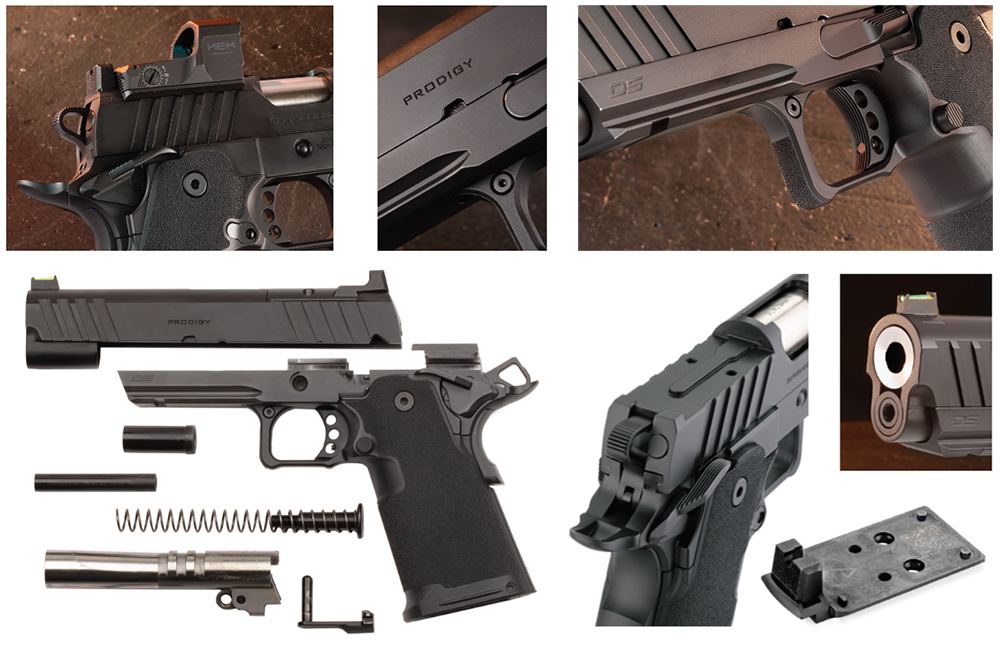
The Prodigy is only offered in 9 mm and it weighs 34.2 ounces unloaded. As heavy as this might seem, Springfield Armory’s 4.25-inch Ronin 1911 in 9 mm weighs 31 ounces and has a standard capacity of only nine rounds. Three ounces is a small price to pay for double the capacity. The very comfortable, but wide, polymer grip on the Prodigy just makes the pistol look heavier than it is. Of course, when you shove a loaded 17-round magazine in the gun, it gains 10 ounces. A fully loaded 26-round magazine and an RMR will add almost a pound.
The Prodigy has a black Cerakote finish, and while very utilitarian in appearance, it also has a sleek-looking, tactical vibe. Fit and finish were as you would expect from Springfield Armory, and just looking at and manipulating the pistol, you get the impression it’s more of a custom creation than a factory-stock product.
Just prior to reviewing the Prodigy, I’d conducted an experiment with a lightweight 27-ounce, 4.25-inch-barrel 1911 in 9 mm. With all that data on hand, I figured exposing the Prodigy to the same drills used in that test would provide some insight into how much easier a 7-ounce heavier, Commander-size 1911 would perform. Since numbers tend to convey performance better than opinion, according to my shot timer, average split times with the Prodigy were 15 percent faster, transition times (the time it took to switch targets) were 31 percent faster and overall, the engagement times with the Prodigy were 19 percent faster. The ability to deliver more rounds on target faster is the advantage of a heavier gun. But, I would be remiss if I left the comparison there.
All these drills were run from the low ready without reloads to eliminate as much human error as possible. However, I did manage to locate a holster that fit the Prodigy well enough to allow some presentation work. Not only does the pistol have a good user interface when it comes to establishing a shooting grip, reloads are speedy, too. This is partly because of the big and easy-to-grasp modular grip and magazines, but also partly because with the taper at the feeding end of the magazines, they easily slid into the wide opening of the Prodigy’s grip module. After years of testing ultra-compact 9 mm handguns that have become the rage, it’s hard to convey how nice and soft-shooting a full-size pistol like the Prodigy is. But, not only can you do everything faster with a Prodigy, you can also do it with more precision.
When I began precision testing from the bench, I installed an AOS plate and a Trijicon RMR. (Additional AOS plates for various reflex-sight footprints are available for $60 each from Springfield Armory.) The pistol was devilishly precise, with the average for all 15 groups an impressive .95 inch.
When testing began, the second and third rounds out of the first 17-round magazine failed to fully chamber. A little slap to the back of the slide sorted this out, and no more stoppages were experienced until I began bench testing after more than 300 rounds had been fired. At this point, there were some additional failures to fully go into battery. So, I field-stripped the pistol and applied some EDC CLP. This fixed the issue, and another 200 rounds were fired without a single stoppage. Even so, I’d rate reliability as good. You must remember this is a match-grade 1911 with tight tolerances. As such, and like all 1911s, the gun needs lubrication. This is not a bad thing; a 1911 is a machine and machines need oil.
The Prodigy is much larger than what has come to be known as a practical concealed-carry gun for the 21st century. But, let’s go back to 1985, when carrying a Commander- or even full-size 1911 or Glock G17 for personal protection was common. There were some smaller guns available then, too, but it seemed the emphasis at the time was on shootability and precision.
You could say Springfield Armory’s Prodigy is a Para-Ordnance-like 1911 that’s been thoroughly refined and zapped into the future. It offers extreme precision, generous capacity and a smooth and sensible, well-engineered melding of steel and polymer. Yeah, it might be more gun than you want to carry every day, but when it comes time for shooting—for seriousness or fun—a miniscule 9 mm that’s hardly larger than your hand cannot compare to the Prodigy. This pistol was explicitly developed to deliver bullets where you want them, and to do it in a hurry. Let’s also not forget that size is not an issue for a home-defense handgun
After several weeks with the Prodigy, I’m finding myself ready to take that back-to-the-future trip—I never did get that Para-Ordnance I so badly wanted. The only question for me and anyone else who might be interested in a tack-driving, soft-shooting, increased-capacity 9 mm, is if the ride is worth the $1,500 it will take to get there.